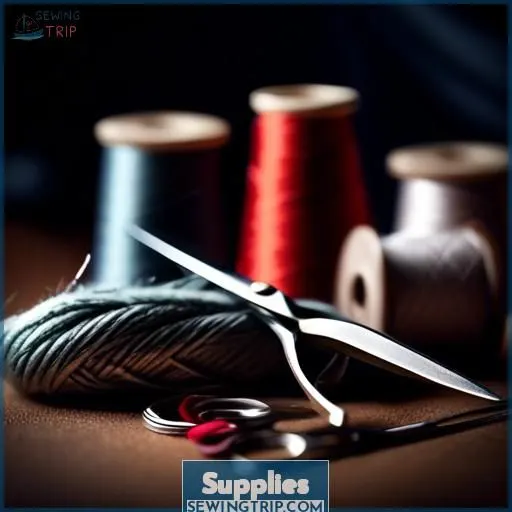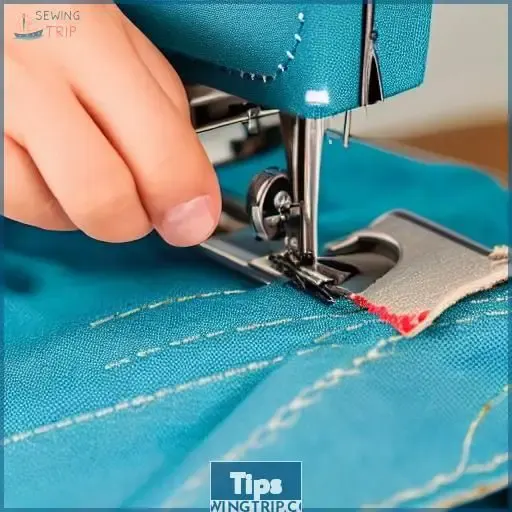This site is supported by our readers. We may earn a commission, at no cost to you, if you purchase through links.

To replace elastic in pants, you’ll first need to remove the old elastic using a stitch ripper.
Cut off any serged fabric attached, then remove the elastic from one edge.
Next, measure your waist and cut a new elastic strip 1 inch less than that measurement.
Align the ends, adjust for comfort, and sew a fabric square to enclose them.
Pin the elastic to the pant’s interior waistband edge, dividing both into quarters for even spacing.
Stitch the elastic in place using a zigzag or coverstitch.
Secure the ends by overcasting.
With a properly fitted elastic waistband, you’ll enjoy renewed comfort and mobility in those beloved pants.
Table Of Contents
Key Takeaways
- Use a serger or sewing machine to replace the elastic in pants.
- Measure your waist and cut a new elastic strip that is 1 inch less than your waist measurement.
- Enclose the elastic ends with a fabric square using a zigzag or coverstitch.
- Divide the pants waistband and elastic circle into quarters for even spacing when attaching the new elastic.
How to Replace Elastic in Pants?
To replace the elastic in pants, follow these steps:
- Check the waistband for places where the elastic is sewn in.
- Open up a hole in the elastic casing.
- Pull out the elastic and cut it to the size of your waist.
- Pin the new elastic to the pants with about a half inch of fabric overlapping.
- Sew the elastic with a zig-zag, overcasting, or joining stitch.
- Sew the ends of the elastic together.
For hidden elastic waistbands, cut a strip of elastic to the size of your waist, find where the old elastic is sewn into the pants, and cut a hole large enough to take out the old elastic and insert the new. Attach a safety pin to one end of the new elastic, insert it into the hole, and start pushing the elastic through. When you get the safety pin through to the other side, attach the two ends together with a pin.
Supplies
To replace the elastic in your pants, you’ll need a serger or sewing machine, wide elastic (waist measurement minus 1 inch), measuring tape, scrap fabric, stitch ripper, thread, scissors, and pins.
Serger or Sewing Machine
In the realm of elastic replacement for pants, both sergers and sewing machines are viable options. Sergers excel in this endeavor, adeptly handling elastic. They deftly gather elastic uniformly on a waistband, crucial for optimal comfort and functionality.
Sergers employ a blade to simultaneously trim excess seam allowance and stitch, producing a polished finish. This makes them the preferred choice for sewing elastic onto garments like pants, guaranteeing a professional outcome.
To utilize a serger for elastic replacement, adhere to these steps:
- Serge the elastic onto the fabric’s underside, stretching it between markers to maintain even distribution.
- Superimpose the elastic at the commencement and continue serging for approximately 1/2 inch to secure it.
- Invert the elastic edge to the fabric’s reverse side and top-stitch it into position using a sewing machine or coverstitch.
- Release the threads, remove excess elastic, and complete the garment assembly.
Remember to employ a wider stitch length when serging extended elastic, as the resulting stitches will contract due to the elastic’s tendency to recoil post-stitching.
Wide Elastic (waist Measurement Minus 1 Inch)
To replace an elastic waistband, you’ll need wide elastic that matches the waist measurement of your pants minus 1 inch. Here’s a list of three important aspects to think about when choosing the right elastic for your project:
- Elastic Width: The width of the elastic can vary from 1/4 inch to 3 inches and up. Choose an elastic width that suits the garment and the location it will be used in.
- Elastic Strength: Think about the strength and durability of the elastic. Different types of elastic, such as knit, braided, woven, and fold-over, have varying properties that can affect the performance of the elastic in your project.
- Elastic Color and Texture: The color and texture of the elastic can also be important, depending on the desired appearance of the finished garment.
Remember to stitch the elastic to the waistband using a zigzag stitch for added strength. Overlap the elastic ends by 1/2 to 1 inch and stitch them together securely.
Measuring Tape
Measuring tape is an indispensable tool for accurately determining the length and circumference of various objects, including your waist measurement for sewing projects. When choosing a measuring tape for sewing, seek one that’s easy to read and accurate, with clear markings in both inches and centimeters.
A tape measure with a dual scale can be particularly handy, as it allows you to switch between measuring systems depending on your project requirements. Additionally, select a tape measure that’s durable and resistant to tearing and stretching, ensuring its accuracy over time.
Scrap Fabric
To swap out the elastic in pants, you’ll need fabric remnants. The fabric pick for this job should be light and weigh close to the original waistband fabric. A serger or sewing machine will be needed for stitching in the new elastic. The fabric kind should be compatible with the elastic you’re using, such as nylon, spandex, or a mix of both.
Stitch Ripper
To use a stitch ripper effectively for elastic replacement and waistband repair, follow these steps:
- Identify the stitches that need to be removed.
- Carefully insert the pointed end of the seam ripper into the stitches one at a time.
- Pull the thread until it comes undone, ensuring not to cut or damage the fabric.
- Repeat this process until all the stitches have been removed, giving you a clean slate for the elastic replacement.
Remember to exercise caution and use proper grip techniques to prevent injuries or fabric damage while using a seam ripper.
Thread, Scissors, Pins
Gather your thread, scissors, and pins—it’s time to embark on the core of your project. Envision your thread as the unacknowledged hero, ensuring your elastic types adhere seamlessly to your fabric. Scissors, incisive as your intellect, execute precise cuts, while pins unite the tapestry—or at least your casing strength and stitching patterns—as one.
Bear in mind, aligning fabric compatibility and seam allowance is crucial for a secure fit.
Remove Old Elastic
To replace the elastic in the waistband of your pants, you’ll need:
A serger or sewing machine
Wide elastic (waist measurement minus 1 inch)
Measuring tape
Scrap fabric
Stitch ripper
Thread
Scissors
Pins
Begin by removing the old elastic.
Use a stitch ripper to remove the stitching holding the elastic to the waistband.
Turn the pants inside out and remove the two rows of stitching.
Cut off the serged fabric attached to the elastic.
Remove the elastic from one edge.
Cut Off the Serged Fabric Attached to the Elastic
To replace the elastic waistband in your pants, you’ll first need to remove the old elastic. This can be done by following these steps:
- Unpick the Serged Stitch: Use a seam ripper to remove the serged stitch from the waistband. Locate the two straight stitches on the serging and carefully rip through one stitch in both of them, without catching the looped threads. Then, gently pull out a few of the straight stitches next to the rip you made to make tails you can grasp. Then, gently pull out the straight stitches, and the looped stitches will unravel themselves.
- Remove the Elastic from One Edge: After the serged fabric is removed, you can now remove the elastic from one edge of the waistband. This will make it easier to replace the elastic later on.
Remember to be patient and careful during this process, as removing the serged stitch and fabric can be a tedious task. Once the old elastic is removed, you can proceed with making a new elastic waistband and attaching it to your pants.
Remove the Elastic From One Edge
To remove the elastic from one edge, follow these steps:
- Use a stitch ripper to remove the stitching holding the elastic.
- Turn the pants inside out and remove the two rows of stitching.
- Cut off the serged fabric attached to the elastic.
- Remove the elastic from one edge, ensuring that the fabric remains intact.
Remember to think about serger considerations and fix assessment before proceeding with the elastic removal process.
Make New Elastic Waistband
To make the new elastic waistband, measure your waist and cut the elastic 1 inch less than that measurement. Next, align the elastic ends and adjust them for a comfortable fit by overlapping or trimming the excess, then enclose the overlapped ends with a sewn fabric square to create a smooth circle.
Measure the Waist and Cut the Elastic 1 Inch Less
To make your pants fit perfectly, grab your measuring tape and wrap it around your waist. Then, play the subtraction game by taking away an inch from that number. This is your ideal measurement for the new elastic. It’s the key to creating a slim waistband that promises both comfort and a snug, perfect fit for a long-lasting repair.
Align the Elastic Ends and Adjust for Comfort
Align the elastic ends and adjust for comfort, ensuring a perfect fit. Remember, the elastic tension should be just right, not too loose or too tight. Consider the comfort level and sizing options for the wearer, as well as the fabric compatibility. Use DIY techniques to make adjustments, ensuring a snug yet comfortable waistband.
Sew the Fabric Square to Enclose the Elastic Ends
To sew the fabric square to enclose the elastic ends, follow these steps:
- Choose the fabric: Select a fabric that complements the elastic and the garment. Consider the fabric’s thickness, comfort next to the skin, and the method of finishing. If the waistband is heavy or thick, it may add bulk to the waistline area. In such cases, consider using a selvage, overlock stitch, or binding the back side to reduce bulk.
- Determine the seam type: Choose a stitch type that’s suitable for the fabric and the elastic. A zigzag stitch is a common choice for added strength.
- Measure the elastic length: Cut the elastic 2-3 inches shorter than the waist measurement to guarantee a comfortable fit.
- Decide on the waistband width: The typical width measurement for a waistband is twice the desired width plus two seam allowances. Adjust the width according to the fabric and the method of finishing.
- Calculate the seam allowance: Add the seam allowance to the elastic measurement before cutting.
- Cut the fabric square: Measure and cut a fabric square that’s large enough to enclose the elastic ends. The size of the square will depend on the width of the elastic and the seam allowance.
- Fold and sew the fabric square: Fold the fabric square over the elastic ends and sew it in place. This will enclose the elastic ends and create a smooth finish.
- Confirm the fit: After sewing the fabric square, check the fit of the elastic circle. Adjust the elastic length and the fabric square as needed to guarantee a comfortable and secure fit.
Confirm the Fit of the Elastic Circle
To confirm the fit of the elastic circle, follow these steps:
- Elastic tension: Make sure the elastic has the correct tension. It should be slightly stretched but not too tight. Adjust the tension if necessary to achieve the desired comfort level.
- Circle circumference: Determine the circumference of the elastic circle. It should be slightly smaller than the waist measurement to allow for ease and comfort.
- Fabric compatibility: Check if the elastic is compatible with the fabric of the pants. Some fabrics may require a specific type of elastic or may need to be treated differently during the sewing process.
- Seam strength: Inspect the seam where the elastic is attached to the waistband. It should be strong and secure to prevent the elastic from coming loose over time.
Remember to adjust the elastic for comfort and make sure it isn’t too tight or too loose. You may need to make small adjustments to the elastic length or the position of the elastic in the waistband to achieve the perfect fit.
Divide the Pants Waistband and Attach Elastic
To attach the new elastic waistband to your pants, you’ll need to divide the pants waistband into four equal sections using the side seams and pins. This ensures that the elastic is evenly distributed and that the waistband remains smooth and even. Divide the elastic circle into four sections with pins as well, aligning the raw edges with the waistband.
Now, you’ll pin the elastic to the inside of the pants, 1/4 inch from the edge. This will create a casing for the elastic to be sewn into. To secure the elastic in place, you can use a zigzag stitch or coverstitch. For added strength, you can also overcast the elastic ends.
To guarantee a perfect fit, you may need to gather the elastic slightly before sewing it into the waistband. This can be done by pulling on the elastic while it’s still attached to the needle or using a gathering foot on your sewing machine. Once the elastic is securely attached, you can enjoy your newly repaired pants!
Remember to maintain a snug waist for growing children and avoid stigmatizing pants for older children. Mending is a great way to save money and reduce waste, especially on gloomy days when you’re looking for a productive activity.
Fold the Elastic Down and Stitch in Place
Now that you’ve successfully connected the elastic to your pants, it’s time to fold it down and sew it in place. Here’s how:
- Fold the Elastic Down: Start by folding the elastic toward the inside of the pants. Aim for a 1/4-inch fold, which will create a clean and neat appearance.
- Pin the Elastic: Once you’ve folded the elastic, use pins to secure it in place. This will help you maintain a consistent fold and make sure that the elastic stays in the correct position while you sew.
- Stitch the Elastic: Using a zigzag stitch, sew the elastic to the waistband. This stitch provides added strength and durability, making sure that your new elastic waistband will last. Remember to use a thread color that matches the fabric of your pants for a seamless look.
Enjoy Your Newly Repaired Pants!
Congratulations! You’ve successfully replaced the elastic in your pants, and now you can enjoy your newly repaired garment.
With customizable waistbands, you can achieve an adjustable fit that suits your needs perfectly.
You’ve also had the opportunity to explore unique fabric choices, making your pants truly one-of-a-kind.
By opting for DIY alterations, you’ve not only saved money but also gained a sense of satisfaction from your sustainable repairs.
Your pants are now ready to serve you well, and you can look forward to many more wears.
So, go ahead and show off your handiwork with pride!
Tips
You’ll want to maintain a snug waist fit for growing children, as their bodies are constantly changing and the elastic may need more frequent adjustments. However, avoid stigmatizing the elastic-waist pants for older children, as they provide a comfortable and practical solution that shouldn’t be a source of embarrassment.
Maintain a Snug Waist for Growing Children
Keeping a comfortable waist for growing children is essential for their well-being, affordability, and durability. Here are three tips to guarantee a perfect fit:
- Measure Consistently: Regularly measure your child’s waist to make sure the elastic waistband remains snug.
- Adjust as Required: Adjust the elastic waistband as your child grows to maintain a comfortable fit.
- Select the Right Elastic: Choose elastic that stretches slightly for a comfortable fit and won’t lose its shape quickly.
Avoid Stigmatizing Pants for Older Children
Avoid stigmatizing pants for older children by embracing the concept of sustainable fashion.
A tailoring solution can be a self-esteem builder and a way to address body image issues.
By choosing to repair and repurpose clothing, you’re promoting a positive attitude about fashion and acceptance of different styles.
This approach can also help foster peer acceptance and encourage a more mindful approach to our wardrobes.
Mending is Ideal for Gloomy Days
Gloomy days and rainy afternoons are perfect for cozying up with creative hobbies.
Seize these quiet moments to mend those loose pants. It’s not just about fixing; it’s about taking control, mastering a skill, and enjoying the freedom of customization.
So, next time the clouds roll in, grab your sewing kit and turn a dreary day into a cozy evening of creativity.
Frequently Asked Questions (FAQs)
How do I remove the old elastic from the waistband?
Sure, get started by carefully using a seam ripper to undo the stitches securing the old elastic in place. Take your time – undoing someone else’s shoddy work requires patience and precision. Once freed, that saggy old elastic can hit the road!
Can I replace the elastic without removing it from the casing?
Ah, you’re tackling that wardrobe warrior – replacing the elastic without disturbing its cozy casing? Let’s weave some magic here: Gently detach one end, thread the new elastic through like a serpent, overlap and secure. Voila! Fresh権権esilienceえ without disrobing your pants.
What width of elastic should I use for replacement?
For waistband replacements, use 1-5 wide elastic. Grab a tape measure and check your existing elastic width – that’s your guide. Too wide and it’ll bunch, too narrow risks tearing through stitches over time. A snug, not restrictive, fit is ideal.
How can I prevent the elastic from twisting inside the casing?
To keep that stretchy serpent from tangling inside its fabric den, simply stitch some evenly spaced rows along the casing’s length – taming that elastic beast with thread’s mighty grip.
Can I use a different type of elastic for replacement?
Absolutely! You can use non-roll elastic or twill tape as replacements. They’ll stay flat in the casing without twisting. Just measure the old elastic’s width to get the right size. Have fun experimenting and reclaiming those pants!
Conclusion
Replacing the elastic in that cherished pair of pants you’ve outgrown or worn out is a fulfilling endeavor.
With the appropriate tools and by following these precise steps on how to replace elastic in pants, you’ll restore vitality to a treasured wardrobe staple.
Enjoy the revived comfort and mobility as you prolong the existence of those beloved trousers.
Honor memories while creating opportunities for fresh experiences.













